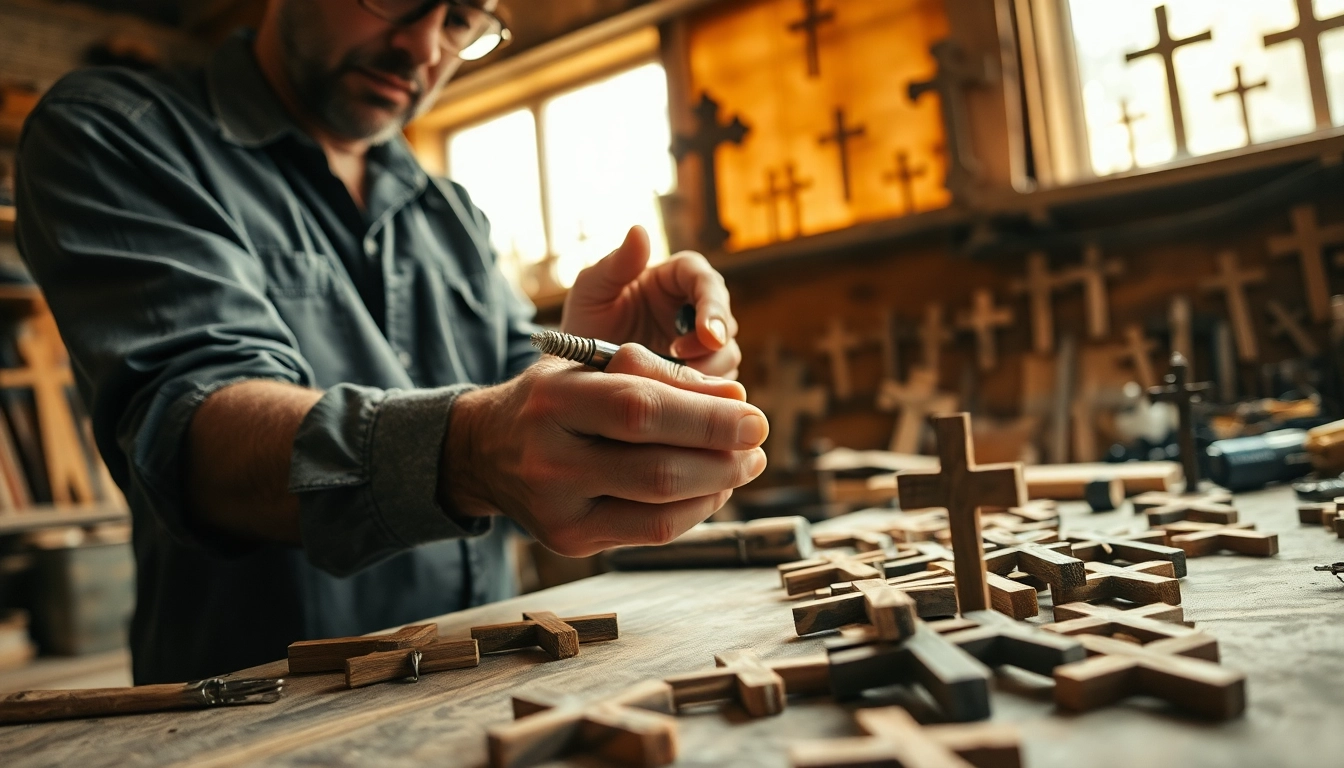Understanding Handmade crosses
Handmade crosses carry deep spiritual and cultural significance for many communities around the world. These items are not merely decorative; they embody centuries of tradition, artistry, and dedication. The craftsmanship behind Handmade crosses ranges from intricate designs carved from locally sourced materials to symbolic representations that connect the maker with a rich heritage. Understanding these elements can enhance one’s appreciation for these unique creations.
History and Significance
The cross is one of the oldest and most recognized symbols in the world, particularly within the Christian faith. Its historical roots can be traced back to Roman times, where it was used as a method of execution. Over time, it has evolved into a symbol of faith, hope, and redemption. Handmade crosses, especially those crafted in locations with cultural richness, often encapsulate stories, beliefs, and traditions specific to their origins. In many cultures, giving or receiving a cross signifies a connection with the divine and a reminder of one’s faith journey.
Materials Used in Crafting
The choice of material in crafting handmade crosses significantly affects their appearance, symbolism, and durability. Here are some commonly used materials:
- Wood: Commonly sourced from local trees, wood offers a warmth and natural beauty to crosses. Olive wood is particularly popular, especially from Bethlehem, due to its rich symbolism within Christian tradition.
- Metal: Metals such as silver, gold, and bronze provide a contrasting finish and are often used for decorative or ornate crosses. The use of metal can elevate the aesthetic appeal and signify luxury.
- Stone: Stone crosses are often more durable and symbolize permanence and stability. Materials like marble or granite are commonly used for outdoor displays.
- Clay and Ceramics: These materials allow for intricate designs and colorful finishes, making them ideal for decorative purposes.
Types of Handmade crosses
Handmade crosses come in various types, reflecting different styles, cultural influences, and purposes:
- Wall Crosses: These are designed for hanging on walls, often featuring intricate carvings or paintings that reflect the maker’s culture.
- Standing Crosses: Typically used for personal altars or memorials, standing crosses offer versatility in placement and often emphasize unique designs.
- Necklace Crosses: Smaller crosses that can be worn as jewelry. They often have personal significance to the wearer.
- Memorial Crosses: These are often associated with commemorating loved ones at gravesites and are crafted with care and respect.
Techniques for Crafting Handmade crosses
Basic Tools and Equipment
The crafting of handmade crosses involves a variety of tools depending on the chosen material:
- For Wood: Basic woodworking tools such as chisels, saws, and sanders are essential. Wood glue and clamps support assembly while finishing tools help with aesthetics.
- For Metal: Tools such as welding torches, metal cutters, and files assist in shaping and finishing metal pieces.
- For Stone: Handsaws, chisels, and polishing pads help artisans shape stones into beautiful forms.
- For Clay: Pottery tools like rollers and molds allow for intricate designs in ceramic crosses.
Step-by-Step Crafting Process
The crafting process for handmade crosses can vary significantly depending on materials and design. A general overview includes:
- Design Planning: Sketching the desired design, considering size, material, and intended use.
- Material Selection: Choosing quality materials is critical; natural, sustainably sourced materials are preferred by many artisans.
- Shaping: Cutting and shaping the material following the planned design.
- Assembly: Joining different parts together if necessary, ensuring structural integrity and aesthetic appeal.
- Finishing: Applying stains, paints, or sealants to enhance appearance and protect the cross from elements.
Finishing Techniques for Excellence
Finishing details are crucial in elevating handmade crosses. Techniques can include:
- Staining and Painting: Enhancing natural beauty or adding colors to complement the design.
- Sanding and Polishing: Providing a smooth finish to prevent splintering, especially in wooden crosses.
- Engravings and Inlays: Adding personal touches that can reflect a person’s faith or culture.
Choosing the Right Handmade crosses for You
Home Decor vs. Gifts
When selecting a handmade cross, consider the purpose. Crosses meant for home decor may prioritize aesthetics and themes that complement interior design, while crosses intended as gifts might focus on personal significance, such as the recipient’s faith journey or cultural heritage.
Cultural and Religious Implications
Handmade crosses can resonate differently depending on cultural contexts. Understanding the cultural implications of the symbols and materials can guide consumers in choosing a cross that aligns with their beliefs or those of the recipient. For example, certain cross designs are regarded as symbols of protection in various cultures, enhancing their significance.
Personalization Options Available
Customization has become increasingly popular in the realm of handmade crosses. Options may include:
- Engraved Names or Dates: Adding personal touch through words that hold significance.
- Custom Designs: Collaborating with artisans to create unique designs that reflect personal faith journeys.
- Pairing with Other Items: Combining crosses with frames, stands, or complementary religious items for a unified presentation.
Care and Maintenance of Handmade crosses
Cleaning and Preservation Tips
Proper care ensures that handmade crosses can be passed down through generations. Basic guidelines include:
- Avoid Moisture: Particularly wood and paper-based crosses should be kept dry to prevent warping and decay.
- Gentle Cleaning: Dusting regularly with a soft cloth avoids accumulation that can tarnish metal or dull finishes.
- Proper Placement: Avoiding direct sunlight can prevent fading and discoloration over time.
Restoration Techniques for Old Crosses
Restoring an old handmade cross requires a careful approach. Techniques can vary based on the material:
- For Wood: Light sanding and re-staining can revitalize an old wooden cross, brought back to life while maintaining its character.
- For Metal: Cleaning with specialized metal cleaners can remove tarnish, while re-polishing may restore shine.
- For Stone: Consulting with a professional is often recommended for significant restorations to prevent damage.
Storing Your Handmade crosses
If not displayed, storing handmade crosses properly helps in preserving their beauty:
- Use Soft Materials: Wrapping in soft fabric protects against scratches or damage.
- Temperature Control: Store in temperature-stable environments to prevent any material distress.
Where to Buy Quality Handmade crosses
Local Artisans and Craft Fairs
Purchasing handmade crosses directly from local artisans or craft fairs supports small businesses and offers a unique opportunity to engage with the creator. These settings often allow for personalized instructions, making your cross even more special.
Online Marketplaces and Custom Orders
The internet has expanded access to artisans worldwide. Many craftsmen and women offer online marketplaces or custom orders, allowing individuals to find one-of-a-kind pieces that suit their personal taste or specific religious needs.
Support for Sustainable Practices in Crafting
As consumer awareness of sustainability grows, many artisans emphasize eco-friendly materials and practices in the creation of handmade crosses. Supporting artisans who prioritize sustainability not only benefits the planet but also enhances the value and story behind the crosses you purchase.



